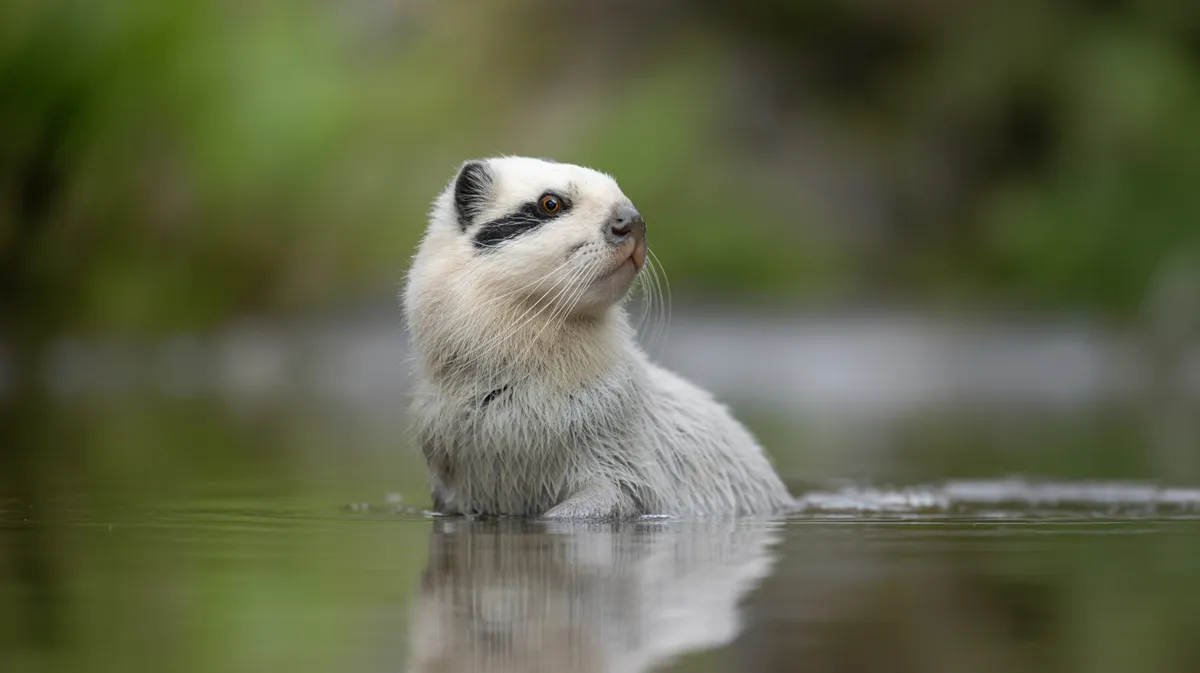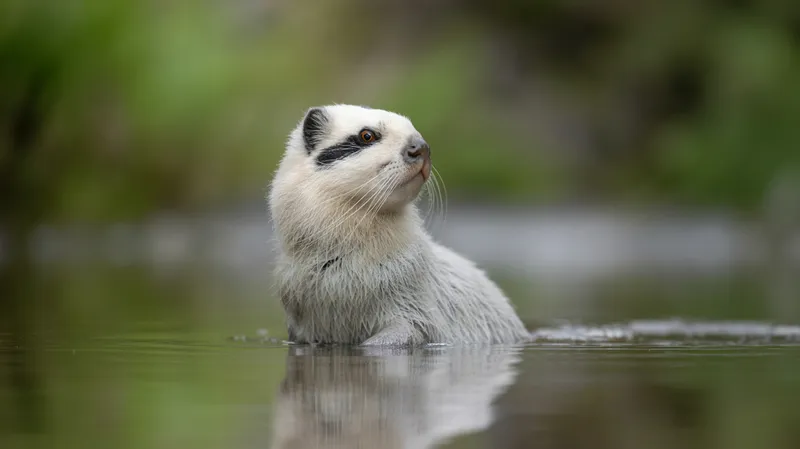
Pyrenean desman
Galemys pyrenaicus

Meet the Pyrenean desman
The Pyrenean desman is a small, semi-aquatic mammal native to the mountainous streams of the Iberian Peninsula and the Pyrenees. It is characterized by its elongated, flexible snout, webbed feet, and dense, waterproof fur, all adaptations for its aquatic lifestyle. This elusive creature is mostly active at night, feeding on aquatic invertebrates and using its sensitive snout to probe underwater. The Pyrenean desman is highly sensitive to water pollution and habitat disturbance, which have contributed to its declining populations.
Classification
Mammal
Habitat
Mountain streams and rivers
Diet
Carnivore
Lifespan
3-4 years
Conservation
Endangered
Weight
35-80 grams
📖Fascinating Facts
Aquatic Specialist
The Pyrenean desman spends most of its life in fast-flowing, clean streams, where it hunts for aquatic insects, larvae, and small crustaceans.
Sensitive Snout
Its elongated snout is packed with nerves and is extremely flexible, helping it locate prey hidden under rocks or sediment.
Webbed Feet
Both the hind and forefeet of the desman are webbed and fringed, providing excellent propulsion while swimming.
📋Detailed Description
The Pyrenean desman (Galemys pyrenaicus) is a small, semi-aquatic insectivore measuring 11–16 cm in body length, with a tail nearly as long (12–16 cm), and weighing between 35–80 grams. Its most distinctive feature is its elongated, highly flexible, trunk-like snout equipped with sensitive vibrissae and electroreceptors, enabling it to detect prey underwater in complete darkness. The body is streamlined, covered in dense, velvety, waterproof fur that insulates against cold mountain streams. Its hind feet are large, webbed, and fringed with stiff hairs, providing powerful propulsion in water, while the tail is laterally flattened and serves as a rudder. The eyes and ears are small and set high on the head, reducing drag and exposure to water. The desman is primarily nocturnal and crepuscular, spending daylight hours in burrows dug into riverbanks. It is a solitary species, with individuals maintaining exclusive territories marked by scent glands. The species is highly specialized for aquatic life, rarely venturing far from water. Its diet consists mainly of aquatic macroinvertebrates, such as insect larvae, crustaceans, and occasionally small fish or amphibians. Breeding occurs once or twice per year, with litters of 1–5 young born after a gestation of about 30 days. The young are altricial, remaining in the nest for several weeks before becoming independent.
💡 Did you know?
Despite being called a 'desman,' the Pyrenean desman is more closely related to moles than to muskrats or otters.
🔬Research & Sources
Wikipedia Summary
The Pyrenean desman or Iberian desman is a small semiaquatic, globally threatened mammal related to moles and shrews, and, along with the Russian desman , is one of the two extant members of the tribe Desmanini. The species occurs in north and central parts of Spain and Portugal, French Pyrenees, and Andorra, but severe range contractions have been documented across its geographic distribution.
Last Modified: 5/18/2025
🎭Behavior & Social Structure
Pyrenean desmans are solitary and territorial, with home ranges that can extend up to 1–3 kilometers of stream length, depending on habitat quality and resource availability. They are predominantly nocturnal, emerging at dusk to forage and returning to their burrows before dawn. Foraging involves continuous underwater probing with the snout, using tactile and electroreceptive cues to locate prey among stones and sediment. They are agile swimmers, capable of remaining submerged for up to 45 seconds, and often use their tails for balance and steering. Desmans communicate primarily through scent marking and occasional vocalizations, especially during the breeding season. Social interactions are limited to brief encounters during mating or territorial disputes, which may involve chases or aggressive posturing. Resting and nesting burrows are constructed in riverbanks above the waterline, with multiple entrances, some of which open underwater for escape from predators.
👶Reproduction & Life Cycle
Breeding in the Pyrenean desman typically occurs in late winter to early spring, though a second breeding period may occur in late summer in favorable years. After a gestation period of approximately 30–35 days, females give birth to litters of 1–5 young in well-concealed nests within their burrows. The young are born blind and hairless, relying entirely on maternal care. Weaning occurs at around 4–6 weeks, after which juveniles gradually disperse to establish their own territories. Sexual maturity is reached at about 12 months. Parental care is provided solely by the female, with no involvement from males post-mating. Reproductive success is closely linked to water quality and prey abundance, making the species vulnerable to environmental fluctuations.
🛡️Adaptations & Survival
The Pyrenean desman exhibits a suite of adaptations for its aquatic lifestyle. Its elongated, prehensile snout is packed with mechanoreceptors and electroreceptors, allowing it to detect minute vibrations and electrical signals from prey. The dense, hydrophobic fur provides thermal insulation and buoyancy, while the webbed and fringed hind feet maximize swimming efficiency. The laterally compressed tail aids in propulsion and maneuverability. Reduced external ears and small eyes minimize water resistance and are adaptations to a primarily tactile and olfactory mode of prey detection. Behavioral adaptations include nocturnal activity to avoid predators and temperature extremes, and the construction of complex burrow systems for shelter and breeding.
📚Research Sources
🎨Cultural Significance
The Pyrenean desman has limited direct cultural significance, largely due to its secretive habits and restricted range. However, it is considered a flagship species for freshwater ecosystem conservation in the Iberian Peninsula and the Pyrenees. In regional folklore, it is sometimes referred to as the 'water mole' or 'ratón de agua,' but it does not feature prominently in myths or traditional practices. Its presence is increasingly valued as an indicator of healthy, unpolluted mountain streams, and it has become a symbol for biodiversity conservation efforts in Spain, Portugal, and southern France.
🔬Recent Research & Discoveries
Recent research has focused on the genetic structure and phylogeography of the Pyrenean desman, revealing significant population fragmentation and low genetic diversity in isolated river systems. Advances in environmental DNA (eDNA) techniques have improved detection and monitoring, allowing for non-invasive population assessments. Studies on habitat use have highlighted the species’ sensitivity to microhabitat features such as substrate composition, water velocity, and riparian vegetation. Conservation genetics is a growing field, with efforts underway to identify genetically important populations and prioritize them for protection. Ongoing research also investigates the impacts of climate change and invasive species on desman populations, with several EU-funded projects supporting habitat restoration and connectivity.
🎥Wildlife Videos

The Mysterious Pyrenean Desman
This hairy and mobile snout belongs to a little creature, native to the Pyrenean mountain chain. Meet the elusive trumpet rat.
Brut America

A Pyrenean desman (Galemys pyrenaicus) from the wild in Portugal.
The National Geographic Photo Ark, led by photographer Joel Sartore, is a multiyear effort to document every species living in ...
Photo Ark

This Tiny Aquatic Mammal Has a Snorkel Snout | Nat Geo Wild
About National Geographic Wild: National Geographic Wild is a place for all things animals and for animal-lovers alike. Take a ...
Nat Geo Animals

"Russian Desman" film
producted by "Bryansk Forest Film Studio", 2002 (11 min, English)
BiodiversityRU

The Russian Desman
Here's a tailored YouTube channel description for **GSJ VIDEOS**, a nature-focused channel: --- **Welcome to GSJ VIDEOS ...
GSJ VIDEOS

Desmana moschata
Desmana moschata.
ketbusiness
🌍Habitat Information
The Pyrenean desman typically inhabits Mountain streams and rivers environments. Pyrenean desmans have adapted to their environments with specialized features and behaviors.
Primary Habitat:
Mountain streams and rivers
More detailed habitat information will be available soon.
🛡️Conservation Status
The Pyrenean desman is currently classified as Endangered. Conservation efforts are crucial for preserving this species for future generations.
Common Threats:
- 🏠Habitat loss and fragmentation
- 🌡️Climate change impacts
- 🎯Hunting and poaching
- 🏭Human-wildlife conflict
⚠️Threats & Conservation Challenges
The Pyrenean desman faces numerous threats, leading to its classification as Endangered by the IUCN. Chief among these are habitat fragmentation and degradation due to dam construction, water abstraction, pollution (especially from agricultural runoff and sewage), and river channelization. Invasive species such as the American mink (Neovison vison) pose predation risks, while introduced fish compete for food resources. Climate change exacerbates these challenges by altering stream flow regimes and increasing the frequency of droughts. Population declines have been documented across much of its range, with local extinctions reported in several river systems. Conservation efforts are hampered by the species’ elusive nature and the difficulty of monitoring populations in rugged, remote habitats.
🔬Scientific Classification
Scientific Name
Galemys pyrenaicus
Classification Hierarchy
🔍 About Taxonomic Classification
Taxonomic classification is a hierarchical system used by scientists to classify and organize living organisms based on shared characteristics and evolutionary relationships.
The system moves from broad categories (Kingdom) to increasingly specific ones, with each animal's scientific name typically consisting of its Genus and species.
📝Community Notes
Share your observations and insights about the Pyrenean desman with our community of wildlife enthusiasts.
Join Our Community
Sign in to share your observations and connect with fellow wildlife enthusiasts.
Sign In to ContributeNo community notes yet
Be the first to share your observations about the Pyrenean desman!
Explore Pyrenean desman
Select a tab above to learn more about this amazing animal.
📸Photo Gallery
No photos available for this animal yet.
🌟Discover More Wildlife
Continue your journey of discovery with more fascinating animals from our database
